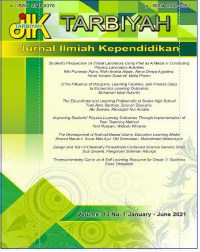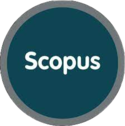Student's Perspective on Virtual Laboratory Using Phet as A Media in Conducting Physics Laboratory Activities
DOI:
https://doi.org/10.18592/tarbiyah.v10i1.4113Abstract
The purpose of writing this paper article is to review students' perceptions in the use of PhET-based virtual labs and also to provide a description in comparison to perceptions of virtual lab use from some of the results of previous studies that are relevant to this study. There are five aspects in the perception that will be surveyed, including; (1) aspects of innovation, (2) aspects of benefits (3) aspects of motivation, (4) aspects of effectiveness, (5) aspects of presenting procedures for laboratory activities. The method used is quantitative and qualitative with a Likert scale questionnaire which must be filled in by 40 people and then interviewing the subjects, after the data is collected, percentage data analysis is carried out. The results of the data analyzed show that the aspects of innovation, effectiveness, benefits and presentation of the procedure get a positive view compared to the motivational aspects which are stated to be negative, so this study also shows that the use of virtual labs based on PhET is innovative and effective, but lacks motivation in its use because of essential activities. laboratory is not felt, in presenting the module is required to increase 4C Skills to support 21st century skillsReferences
Abdulwahed, M., & Nagy, Z. K. (2013). Developing the TriLab, a triple access mode (hands-on, virtual, remote) laboratory, of a process control rig using LabVIEW and Joomla. Computer Applications in Engineering Education, 21(4), 614–626. https://doi.org/10.1002/cae.20506
Arista, F. S., & Kuswanto, H. (2018). Virtual physics laboratory application based on the android smartphone to improve learning independence and conceptual understanding. International Journal of Instruction, 11(1), 1–16. https://doi.org/10.12973/iji.2018.1111a
Dalgarno, B., Bishop, A. G., Adlong, W., & Bedgood, D. R. (2009). Effectiveness of a Virtual Laboratory as a preparatory resource for Distance Education chemistry students. Computers and Education, 53(3), 853–865. https://doi.org/10.1016/j.compedu.2009.05.005
Darrah, M., Humbert, R., Finstein, J., Simon, M., & Hopkins, J. (2014). Are Virtual Labs as Effective as Hands-on Labs for Undergraduate Physics? A Comparative Study at Two Major Universities. Journal of Science Education and Technology, 23(6), 803–814. https://doi.org/10.1007/s10956-014-9513-9
Dyrberg, N. R., Treusch, A. H., & Wiegand, C. (2017). Virtual laboratories in science education: students’ motivation and experiences in two tertiary biology courses. Journal of Biological Education, 51(4), 358–374. https://doi.org/10.1080/00219266.2016.1257498
Faour, M. A., Ayoubi, Z., & The, Z. (2018). The Effect of Using Virtual Laboratory on Grade 10 Students’ Conceptual Understanding and their Attitudes towards Physics. Journal of Education in Science Environment and Health, 4(1), 54–68. https://doi.org/10.21891/jeseh.387482
Kukreti, A. R., Zaman, M., Gramoll, K., & Lee, J. H. (2002). Virtual laboratory modules for undergraduate strength of materials course. ASEE Annual Conference Proceedings, 1, 4865–4873. https://doi.org/10.18260/1-2--11280
Lynch, T., Learning, I. G.-E. I., & undefined 2018. (2018). Innovative pedagogies and personalisation in STEM education with NEWTON Atomic Structure Virtual Lab. Learntechlib.Org, 1483–1491. https://www.learntechlib.org/p/184368/
Oidov, L., Tortogtokh, U., & Purevdagva, E. (2012). Virtual laboratory for physics teaching. 2012 International Conference on Management and Education Innovation, 37, 319–323. http://www.ipedr.com/vol37/062-ICMEI2012-E10015.pdf
Perkins, K., Adams, W., Dubson, M., Finkelstein, N., Reid, S., Wieman, C., & LeMaster, R. (2006). PhET: Interactive Simulations for Teaching and Learning Physics. The Physics Teacher, 44(1), 18–23. https://doi.org/10.1119/1.2150754
Prihatiningtyas, S., Prastowo, T., & Jatmiko, B. (2013). Imlementasi simulasi phet dan kit sederhana untuk mengajarkan keterampilan psikomotor siswa pada pokok bahasan alat optik. Jurnal Pendidikan IPA Indonesia, 2(1), 18–22. https://doi.org/10.15294/jpii.v2i1.2505
Prima, E. C., Putri, A. R., & Rustaman, N. (2018). Learning solar system using PhET simulation to improve students’ understanding and motivation. Journal of Science Learning, 1(2), 60. https://doi.org/10.17509/jsl.v1i2.10239
Putra, R. P., & Anjani, R. A. (2020). Analisis Pemahaman Siswa Kelas 12 di SMAN 1 Cileunyi terhadap pembelajaran Fisika Online selama pandemi CoVid-19. Jurnal Profesi Keguruan, 6(2), 167–173.
Putra, R. P., Silvianti, N., Idris, S. F., & Nabilla, N. (2021). Uji Perbandingan Virtual Lab dengan Real Lab pada Hukum Archimedes. Radiasi : Jurnal Berkala Pendidikan Fisika, 14(1), 23–33. https://doi.org/https://doi.org/10.37729/radiasi.v14i1.897
Putry, A. A., Pratama, A. C., & Delima, E. (2017). Enhancing Physics Student’s Achievement Through Problem Based Learning Assisted PhET on High School. Chair Person, 189.
Rochmah, N. H., & Madlazim. (2013). Media Lab Virtual Phet Pada Materi Sub Pokok Bahasan Fluida Bergerak Di Man 2 Gresik. 02(03), 162–166.
Safitri, D., Setiawan, A., Suhandi, A., Malik, A., Sahida Lisdiani, S. A., & Sapriadil. (2019). The Effects of Higher Order Thinking (HOT) Laboratory Design in Hooke Law on Student’s Creative Thinking Skills. Journal of Physics: Conference Series, 1204(1), 0–6. https://doi.org/10.1088/1742-6596/1204/1/012037
Špernjak, A., & Šorgo, A. (2018). Differences in acquired knowledge and attitudes achieved with traditional, computer-supported and virtual laboratory biology laboratory exercises. Journal of Biological Education, 52(2), 206–220. https://doi.org/10.1080/00219266.2017.1298532
Subali, B., Rusdiana, D., Firman, H., Kaniawati, I., & Ellianawati, E. (2017). Computer-based experiment of free fall movement to improve the graphical literacy. Jurnal Pendidikan IPA Indonesia, 6(1), 41–48. https://doi.org/10.15294/jpii.v6i1.8750
Sugiyono. (2013). Metode Penelitian Kombinasi. In Metode Penelitian Kombinasi (1st ed.). Alfabeta. https://doi.org/10.1145/3132847.3132886
Sulistiowati, N., Yuanita, L., Prodi, P., Sains, P., & Negeri, U. (2013). Perbedaan Penggunaan Laboratorium Real dan Laboratorium Virtual Pada Keterampilan Proses dan Hasil. Pendidikan Sains Pascasarjana Universitas Negeri Surabaya, 2(2), 191–197.
Supurwoko, S., Cari, C., Sarwanto, S., Sukarmin, S., Budiharti, R., & Dewi, T. S. (2017). Virtual Lab Experiment: Physics Educational Technology (PhET)Photo Electric Effect for Senior High School. International Journal of Science and Applied Science: Conference Series, 2(1), 381. https://doi.org/10.20961/ijsascs.v2i1.16750
Suryanti, E., Fitriani, A., Redjeki, S., & Riandi, R. (2019). Persepsi Mahasiswa terhadap Penggunaan Virtual Laboratory dalam Pembelajaran Biologi Molekuler. Journal of Natural Science and Integration, 2(2), 32. https://doi.org/10.24014/jnsi.v2i2.7884
Tzafestas, C. S., Palaiologou, N., & Alifragis, M. (2006). Virtual and remote robotic laboratory: Comparative experimental evaluation. IEEE Transactions on Education, 49(3), 360–369. https://doi.org/10.1109/TE.2006.879255
Downloads
Published
How to Cite
Issue
Section
License
Authors retain copyright and grant the journal right of first publication with the work simultaneously licensed under a Creative Commons Attribution 4.0 International License that allows others to share the work with an acknowledgment of the work's authorship and initial publication in this journal.




